Hermann’s tortoise (Testudo hermanni) is one of the most popular species of pet tortoises due to its manageable size, docile nature, and striking appearance. Whether you’re considering bringing one into your home or already have one, ensuring proper care is essential to keeping your tortoise healthy and happy. In this comprehensive guide, we’ll explore everything you need to know about caring for a Hermann’s tortoise, from its natural habitat to its diet, lifespan, and conservation efforts.
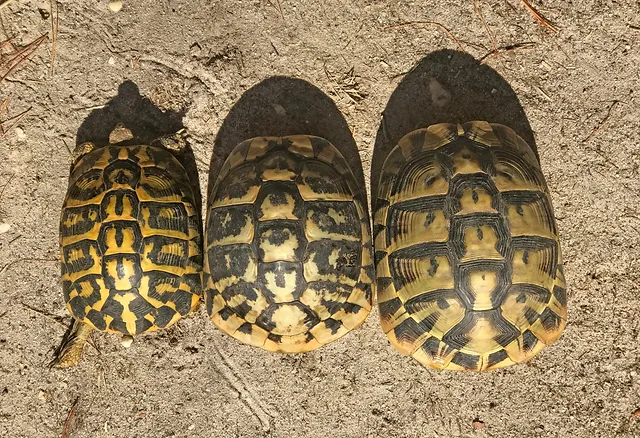
Hermann’s Tortoise Overview
Hermann’s tortoise is native to the Mediterranean, specifically found in countries like Italy, Spain, France, and the Balkans. There are two primary subspecies: the Western Hermann’s tortoise (Testudo hermanni hermanni) and the Eastern Hermann’s tortoise (Testudo hermanni boettgeri). Though they share many similarities, the Western subspecies tends to be smaller and has a brighter yellow coloring, while the Eastern subspecies is slightly larger and has a duller appearance.
Physical Characteristics
Hermann’s Tortoises are characterized by their striking yellow-orange domed shells adorned with prominent black patterns. Their heads are typically brown or black, featuring a yellow spot on each side. The upper jaw has a slight hook and is equipped with a hard beak. Their limbs are scaly and can appear grayish or brown, often with yellow markings. Male Hermann’s Tortoises have longer and thicker tails compared to females, with a spur—a hard spike—at the end. These tortoises usually do not exceed 18 cm (7.5 in) in length and can be as small as 7 cm (3 in). In a captive environment, they have been known to live for up to 30 years.
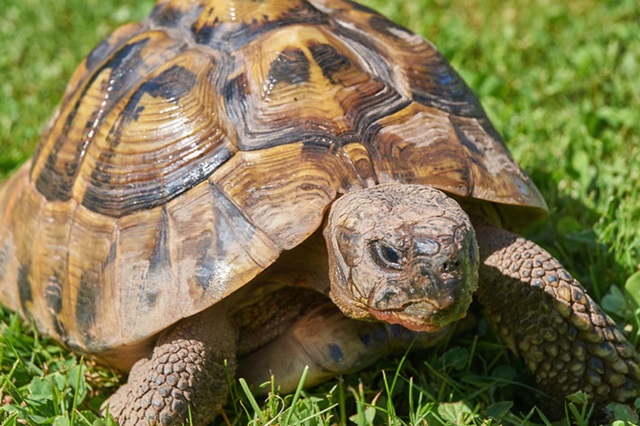
Habitat: Wild vs. Captivity
Natural Habitat
In the wild, Hermann’s tortoises thrive in the warm, dry climates of the Mediterranean, living in areas with plenty of vegetation and sandy or rocky terrain. They are most active during spring and fall, as the summer heat forces them into hiding to avoid dehydration.
Creating the Perfect Captive Habitat
If you’re keeping a Hermann’s tortoise in captivity, recreating its natural habitat as closely as possible is crucial. Here’s what you’ll need:
- Enclosure Size: For a single tortoise, aim for at least a 4×2 foot enclosure. If you can provide a larger space, that’s even better.
- Substrate: Use a mix of topsoil and sand or coconut coir, which mimics the tortoise’s natural environment. Avoid substrates like gravel or pine shavings, which can harm your tortoise.
- Temperature and Lighting: Hermann’s tortoises require a basking area of around 90–95°F (32–35°C) and a cooler area of 70–75°F (21–24°C). Use a UVB light to replicate sunlight, essential for their calcium metabolism and overall health.
- Humidity: Keep the humidity around 30–50%, and provide a shallow water dish for them to soak and stay hydrated.

Diet and Feeding
Natural Diet
In the wild, Hermann’s tortoises are strictly herbivorous, feeding on a variety of fibrous plants, weeds, and grasses. Their natural diet is high in fiber and low in protein, which keeps their digestive systems functioning well and helps prevent obesity and other health issues.
Diet in Captivity
For a captive Hermann’s tortoise, it’s vital to replicate this diet. Offer a mix of leafy greens like dandelion, kale, and collard greens, alongside grasses and flowers like hibiscus. Limit fruits and avoid high-protein foods such as dog or cat food, as these can cause liver and kidney problems. You may also want to provide calcium supplements to ensure their shells stay strong.
Pro Tip: Introduce variety in their diet by including edible weeds and plants that you can grow yourself, like clover or plantain. This not only mirrors their wild diet but keeps your tortoise mentally stimulated.
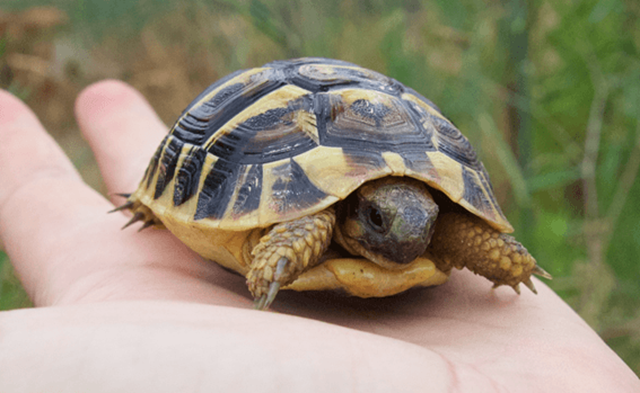
Lifespan and Health
Average Lifespan
Hermann’s tortoises are long-lived reptiles, with an average lifespan of 50–75 years in captivity when properly cared for. Some have been known to live beyond 100 years! Because of this, adopting a tortoise is a long-term commitment, and potential owners should be prepared for decades of care.
Common Health Issues
Even with the best care, Hermann’s tortoises are susceptible to certain health problems. Here are some of the most common:
- Respiratory Infections: These can occur if the tortoise is kept in an enclosure that’s too cold or humid. Signs include wheezing, nasal discharge, and lethargy.
- Shell Rot: A bacterial or fungal infection that can result from unsanitary living conditions. Ensure your tortoise’s habitat is clean and dry.
- Metabolic Bone Disease: This condition is caused by a lack of calcium or UVB exposure, leading to softening of the bones. Make sure your tortoise gets proper UVB lighting and a calcium-rich diet.
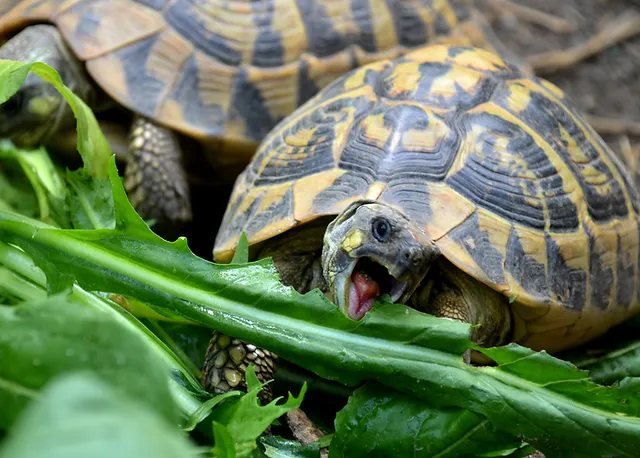
Breeding and Hibernation
Breeding in Captivity
Hermann’s tortoises are capable of breeding in captivity if provided with the right conditions. They typically mate in the spring, and females lay eggs in shallow nests. If you’re considering breeding your tortoises, ensure you have adequate space and resources for the hatchlings.
Hibernation
One of the most unique aspects of tortoise care is hibernation, which can last anywhere from 3 to 5 months depending on where you live. Before hibernation, your tortoise should fast for several weeks to empty its digestive tract. It’s important to monitor your tortoise’s health before hibernation and provide a safe, cool place where it can rest undisturbed.
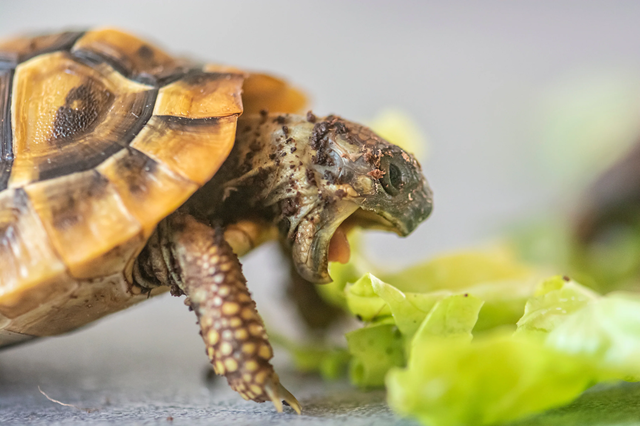
Conservation Status and Efforts
Endangered Status
Hermann’s tortoise is listed under Appendix II of CITES, meaning it is a species that is not necessarily threatened with extinction but may become so unless trade is closely controlled. Habitat loss, illegal pet trade, and the destruction of their natural environment pose significant threats to their populations in the wild.
How You Can Help
As a responsible tortoise owner, you can play a role in conservation. Avoid buying wild-caught tortoises, and instead purchase from reputable breeders who prioritize conservation. Additionally, supporting organizations that work to protect Mediterranean habitats is a great way to contribute to the preservation of Hermann’s tortoises.

Choosing Hermann’s Tortoise as a Pet
What to Look For
If you’re planning to adopt a Hermann’s tortoise, look for one that has bright, clear eyes, a smooth shell, and is active and alert. Avoid tortoises that appear lethargic, have sunken eyes, or display signs of respiratory illness.
Where to Buy
Always buy from a reputable breeder or adoption center to ensure your tortoise is healthy and ethically sourced. Avoid pet stores that may not be knowledgeable about their care, or worse, sell wild-caught tortoises.
Hermann’s tortoises make wonderful companions for those committed to their long-term care. By providing the right diet, habitat, and attention to their unique needs, you’ll have a happy, healthy tortoise for decades. Whether you’re a new owner or a seasoned enthusiast, remember that your commitment to responsible ownership and conservation helps protect this incredible species for generations to come.
FAQ
- How long do Hermann’s tortoises live in captivity? With proper care, they can live for 50–75 years, and in some cases, even longer.
- What do Hermann’s tortoises eat? They are herbivorous, enjoying a diet of leafy greens, weeds, and flowers. It’s essential to avoid high-protein foods.
- How can I set up the perfect enclosure for my Hermann’s tortoise? Your enclosure should be spacious, with a substrate of topsoil and sand, and a temperature gradient of 70–95°F. Proper UVB lighting and a low-humidity environment are crucial.
- Do Hermann’s tortoises need special care during hibernation? Yes, hibernation requires careful preparation, including monitoring your tortoise’s health and fasting them before the hibernation period begins.
